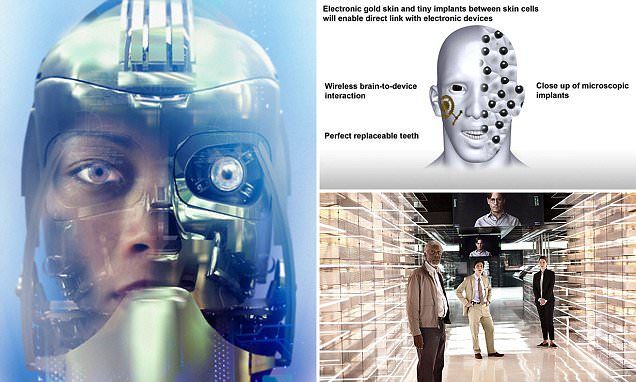Page 11851
Feb 2, 2016
Steven Spielberg Working on a Project “Solely for VR”
Posted by Shailesh Prasad in categories: media & arts, virtual reality
Virtual reality was almost hot enough at Sundance this year to melt the snow, but perhaps the most scorching news of the show was casually dropped during the high profile Technicolor panel. Virtual Reality Company (VRC) co-founder and Maleficent director Robert Stromberg declared his company is working with Steven Spielberg on a project that is “solely for VR.”
Responding to a question about how to take VR filmmaking to the next level, Robert Stromberg said “it is about getting other filmmakers interested of course, from the independent level to getting major players involved as well… I can say here, my company – VRC – we’re working with, for instance, Steven Spielberg on a project that’s solely for VR.”
We previously reported that Steven Spielberg signed on as one of the company’s advisors, but at the time there was no confirmation on his involvement with any projects. But with Spielberg set to direct Ready Player One, a film with VR central to the theme, it seemed like a foregone conclusion that he would be dipping his fingers into virtual reality at some point in the near future.
Feb 2, 2016
Smartphones Could Generate Own Power with New Coating
Posted by Shailesh Prasad in categories: computing, materials, mobile phones
A transparent material that can be attached to a smartphone’s touch screen could help the device generate electricity whenever anyone taps it, researchers in China say.
Touch screens are now found on most cell phones and tablet computers. Using a touch screen typically involves finger taps, and scientists at Lanzhou University in China reasoned that the mechanical energy from these motions could be converted into electricity to charge the phone’s batteries, which could significantly extend the working time of these portable devices.
The researchers developed a new material based on a transparent silicone rubber known as PDMS. Scientists embedded wires in this rubber that were made of lead zirconate titanate that were only 700 nanometers, or billionths of a meter, wide. For perspective, this is about 140 times thinner than the average width of a human hair. [Top 10 Inventions That Changed the World].
Feb 2, 2016
Yamaha, SRI team up on humanoid robot to test motorcycle safety, push performance — and much more
Posted by Dan Kummer in categories: cyborgs, robotics/AI, space, transportation
The San Jose Mercury News took a look at SRI’s collaboration with Yamaha to develop Motobot, the first motorcycle-riding humanoid robot. “Consider it a high-tech diagnostic tool for motorcycles that just happens to look like a cyborg.”
Feb 2, 2016
Futurologist Dr Ian Pearson says technology is causing humans to ‘evolve’
Posted by Karen Hurst in categories: evolution, health, materials, quantum physics, robotics/AI

I still get a kick out of these types of articles because it is the classic “Fear of the Unknown” getting folks worked up. A) we don’t have enough information to confirm or not confirm whether humans will totally disappear and morph into a half Human and half machine species. B) it doesn’t scare me at all because I will make the choice if I decide that I want or need an implant. And, if I do, then more than likely it was to help me beat a disease like cancer or to enrich my life somehow just like I would opt for a surgery or procedure today. Nothing more.
However, there is one thing that is certain and that is Quantum Technology itself is going to truly transform everything in our lives. And, I mean EVERYTHING (medical/ healthcare, manufacturing, AI, devices, communications, services, raw materials enrichment, etc.).
Continue reading “Futurologist Dr Ian Pearson says technology is causing humans to ‘evolve’” »
Feb 2, 2016
Warning Space Aliens: Earth’s UFO- Hunting Satellite Is Coming For You
Posted by Sean Brazell in categories: alien life, satellites

It seems like every day, a video or image emerges that appears to show a UFO near the International Space Station. And it generally — OK, always — turns out not to be a UFO. It’s normally space debris, light reflections from the station windows, an antenna attached to the station, etc.
But wouldn’t it be interesting if someone actually launched a satellite into Earth orbit (illustrated above), with the specific mission of trying to detect and prove unknown objects are actually out there?
Continue reading “Warning Space Aliens: Earth’s UFO- Hunting Satellite Is Coming For You” »
Feb 2, 2016
Our Galaxy Might Have Already Died — We Just Don’t Know It Yet, Scientist Warns
Posted by Sean Brazell in category: space
It sounds fairly alarming — but a scientist claims that our galaxy may not just be in the process of dying, but already be dead. Kevin Schawinski of the Swiss Federal Institute of Technology, Zurich, explains that galaxies ‘die’ when they stop forming new stars from gas. ‘This may sound scenic, but refers to the population between the blue star-forming galaxies (the ‘blue cloud’) and the red, passively evolving galaxies (the ‘red sequence’).
Feb 2, 2016
Why Ray Kurzweil’s Predictions Are Right 86% of the Time
Posted by Shailesh Prasad in categories: computing, internet, law, Ray Kurzweil, singularity
It’s that time of the year again when techno pundits are once again breathlessly telling us all about the technology and innovation trends that will be big in 2013. That’s great, but many of those predictions will be hopelessly wrong by the end of March. That’s why it’s so fascinating that Ray Kurzweil, one of the leading thinkers when it comes to the future of technology, has had such a strong track record in making predictions about technology for nearly two decades. In fact, of the 147 predictions that Kurzweil has made since the 1990’s, fully 115 of them have turned out to be correct, and another 12 have turned out to be “essentially correct” (off by a year or two), giving his predictions a stunning 86% accuracy rate. So how does he do it?
The fact is, Ray has a system and this system is called the Law of Accelerating Returns. In his new book How to Create a Mind: The Secret of Human Thought Revealed, Kurzweil points out that “every fundamental measure of information technology follows predictable and exponential trajectories.” The most famous of these trajectories, of course, has been the price/performance path of computing power over more than 100 years. Thanks to paradigms such as Moore’s Law, which reduces computing power to a problem of how many transistors you can cram on a chip, anyone can intuitively understand why computers are getting exponentially faster and cheaper over time.
The other famous exponential growth curve in our lifetime is the sheer amount of digital information available on the Internet. Kurzweil typically graphs this as “bits per second transmitted on the Internet.” That means the amount of information on the Internet is doubling approximately every 1.25 years. That’s why “Big Data” is such a buzzword these days — there’s a growing recognition that we’re losing track of all the information we’re putting up on the Internet, from Facebook status updates, to YouTube videos, to funny meme posts on Tumblr. In just a decade, we will have created more content than existed for thousands of years in humanity’s prior experience.
Feb 2, 2016
The Augmented Reality Revolution
Posted by Shailesh Prasad in category: augmented reality

“The augmented reality revolution will merge the physical and the digital worlds.”
Join Jason Silva as he freestyles complex systems of society, technology and human existence and discusses the truth and beauty of science in a form of existential jazz.













